Archive for the ‘public_art’ Category
“Once Upon a Place” at Time Square
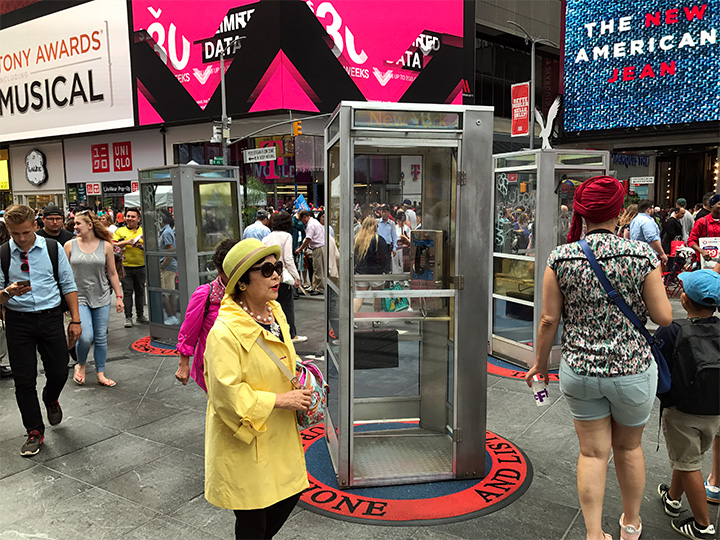
“Once Upon a Place” by Aman Mojadidi at Time Square
Repurposed public phone booths are a poor vehicle for the sharing of immigrant stories. As an artist largely dedicated to reflecting upon migrant populations and cultural dislocation, as soon as I heard about Aman Mojadidi’s “Once Upon a Place”, installed at Time Square, I knew that I needed to visit the project. I worked out a deal with my son and hauled him up to Time Square. Upon entering Duffy Square, we encountered three old phone booths sitting on red and blue carpets with phrases such as “Global Stories” along the circular perimeter.
The first one I entered did not appear to function. I picked up the receiver, put it to my ear and heard only silence. I searched for instructions on the phone as I pushed the numerical keypad, nothing. I pulled out the phone book hanging below a steel shelf, but there was no information as to how to activate the phone. I considered putting coins in the slot, but didn’t have any. So then I stepped out, and read the signage for the project, still no instructions. At this point, the other phones were empty so I tried a second phone booth.
Upon putting the receiver to my ear, I heard the voice of a woman. She was from Mexico and she was describing the hardships and poverty of her home town. The story was brief. She was followed by a man from West Africa, I do not recall the country. He has well explained his desire for a new life due to the intense poverty of his upbringing. The next man, if I recall correctly was Dominican and he explained how his entire family had immigrated to the United States. He was left alone in his country, so he felt that he had little choice but to migrate to the United States…
I believe that the reason that I don’t recall details from these personal stories, besides the fact that it was hot and uncomfortable in the phone booth, is that they were not very interesting. The use of the repurposed phone booth to share immigrant tales is clever (though I don’t recall and can’t imagine a phone booth ever being a popular means to call family across borders), but the framing and presentation of the content does not make the work compelling. Ultimately, the work relies on the strength of the subjects the artist has captured and the artist’s capability to steer the conversation or interview and stir nuance from the subject. The three subjects (of 70) that I listened to were not engaging story tellers. Their experiences were sad and clearly state the need to escape a harsh reality and yet they did not summon empathy or any emotional reaction in me.
However, my time with the project was cut short, by a bored nine year old, who started tapping down the phone’s hookswitch and with each tap the voice from the receiver would go silent. The recording would not pause as when he lifted the hookswitch and I heard the voice again, it did not begin from the stopping point, but rather the audio was continual. So once we were both frustrated, I relented to his desire to move on.
We sat in the stands over looking Duffy Square and ate lunch. I continued to observe the installation. Sadly there was very little interest in the project from the throngs of tourists on a summer Saturday afternoon as the phone booths remained largely empty. Occasionally a curious tourist would poke her head in, listen for a few seconds and then walk out.
My take away from interacting with the installation and observing the public interest: a multitude of stories or interviews, apparently a total of 70, does not generate an interesting project. A single compelling story teller is more significant than many interviewees. Secondly, I found the combination of the immediate surroundings and the heat within the phone booth too distracting to focus on the audio for very long. Time Square is not a good location for audio installations that rely upon focused engagement. Lastly, I’ve got to stop taking my son to see art work that I wish to engage with for any extended period of time. Perhaps, I’ll go back at night by myself and have a different experience.
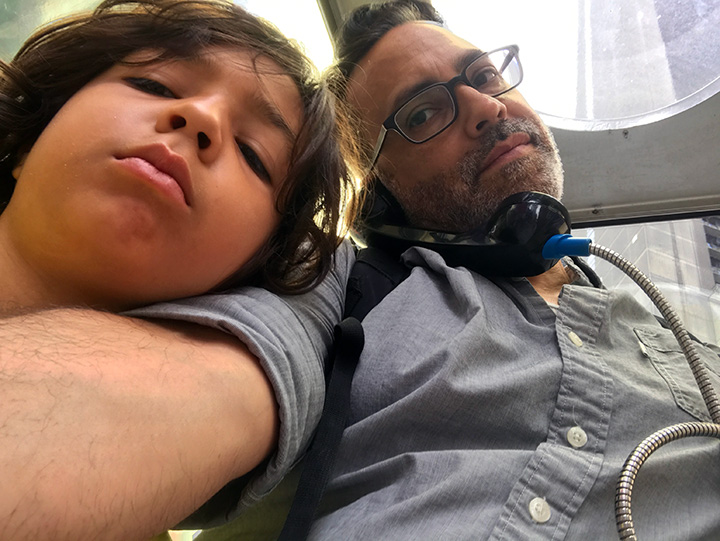
Sharing the phone at Aman Mojadidi’s “Once Upon A Place”
The installation commissioned by Time Square Arts will continue to be available until September 5th at Duffy Square – West 46th Street and Seventh Avenue.
The Voice Who
On a February Friday afternoon walking along Fulton near Nostrand in Brooklyn, my son and I encountered an artist/writer/performer/thinker mounting painted wooden statements or declarations to the temporary plywood of a construction site. We paused to ask him about his declarations and he broke them down one by one. According to the artist each sign represents a book that he is working on, but they also sound like moments and reflections from his life.
On View at Cuchifritos Gallery
Artist Antonia Pérez creates sculptures by weaving discarded plastic bags. She worked at the gallery during the exhibition.
This is the final weekend for the exhibition “Lettuce, Artichokes, Red Beets, Mangoes, Broccoli, Honey and Nutmeg: The Essex Street Market as Collaborator” at Cuchifritos Gallery located in the Essex Street Market. The exhibition curated by Nicolás Dumit Estévez Raful has been in the works for the past two years. The premise of the exhibition is for “six socially conscious artists to engage vendors, customers and the Market itself in their artistic processes as a means of co-generating experiences centered on the life that unfolds outside Cuchifritos Gallery, the art space of the Artist Alliance Inc”.
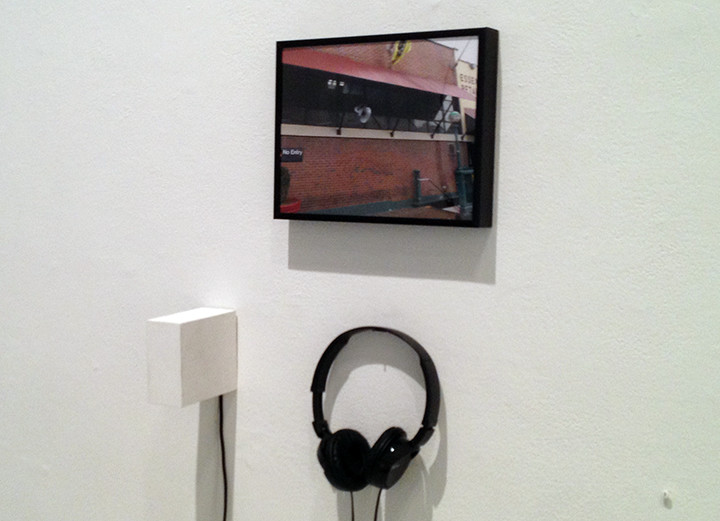
“Recetas y Gangas: The Essex Street Market Recordings” with mock up of originally proposed installation of bullhorn on the facade of the market
So in preparation for the exhibition, the artists came together with Jodi Waynberg the Executive Director of Artist Alliance as well as Nicolas to begin considering how the artists might work with the market. Jodi toured the artists through the market and introduced them to various vendors as well as the building manager and staff. Nearly all the artists attended a Vendors Association Meeting to present their projects and solicit collaboration.
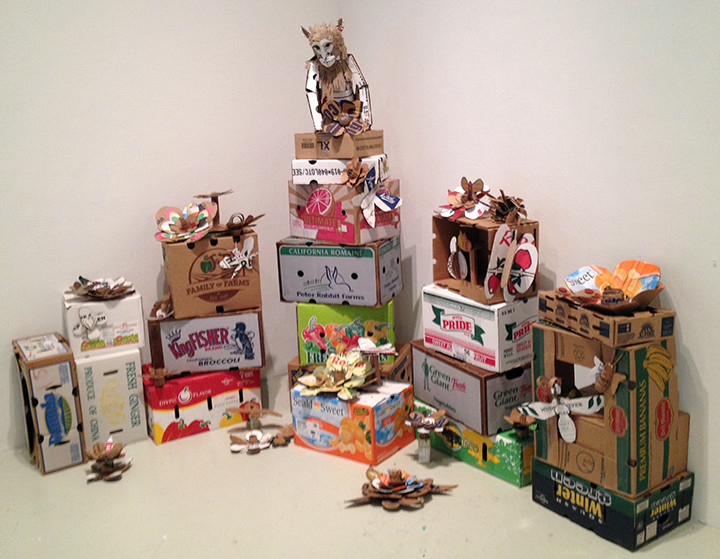
“Refuse Redo” a collaboration between Mary Ting and Lower East Side Girls Club/La Tiendita – sculptures made from market cardboard.
As one may imagine, the vendors are small business owners and workers. The market is the place that they go to for employment, not necessarily for cultural engagement. Many of the vendors are entirely preoccupied with maintaining their business and were no nonsense about artistic participation. If the artists did not approach with a brief and concrete plan for collaboration, there was little chance of any cooperation. A few vendors were excited at the prospect of creative engagement and happily collaborated. However in general, the ambitious projects envisioned by the artists needed to be simplified.
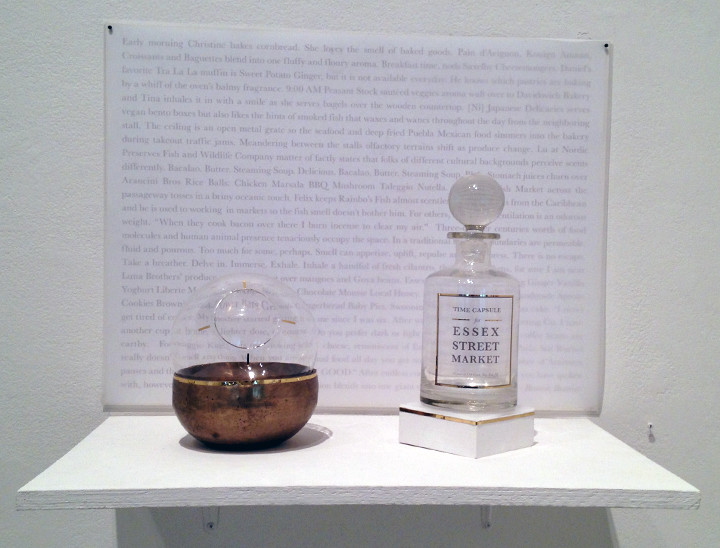
Scent and air time capsule of the Essex Street Market by Beatrice Glow.
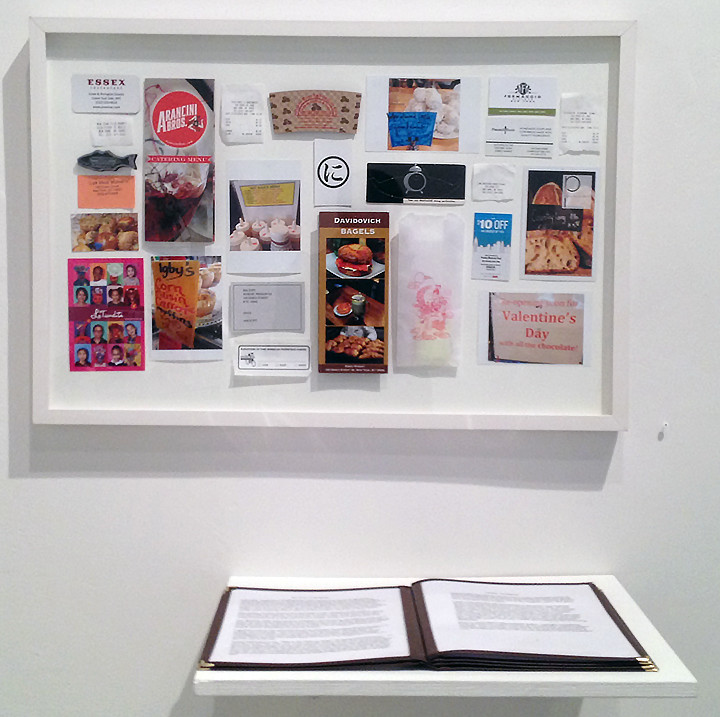
Market collection and journal by Inspector Collector Harley Spiller.
Laia Solé and Nicolás Dumit Estévez Raful employ the color green from the market to create a video montage that collapses the artists at work and the market at work.
For example, I wanted to create an audio montage of the vendors chanting or singing their goods and then to have that audio amplified onto the street via a bullhorn installed on the facade of the Essex Street Market. The concept was to have the interior of the market spill out onto the street as street markets commonly do in Latin America and Europe. Most of the vendors were not comfortable in singing their goods and the building management did not allow the installation of the bullhorn due to city ordinances regarding noise pollution (at least that was their excuse). When I was recording one of the vendors, a shopper approached me to tell me about recipes that she uses for a particular root. It then occurred to me that if vendors did not want to sing, perhaps they would share a recipe and the audio montage became primarily recordings of market recipes. As the piece would not be projected onto the street via a loudspeaker, I created a sandwich board with a speaker installed into it and wore the sandwich board on the street. In this way, the original concept of the piece was fully realized.
Each artist has her or his own story of how the work needed to be modified for the final exhibition. And in the end, this is the nature of collaboration.
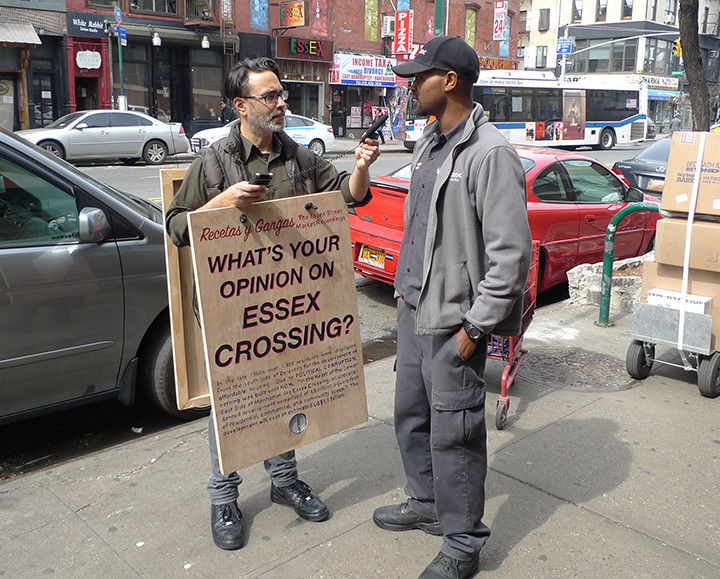
“Recetas y Gangas: The Essex Street Market Recordings” with mock up of originally proposed installation of bullhorn on the facade of the market
The Essex Street Market Recordings

Proposed work “Recetas y Gangas” audio montage of vendors projected onto the street through a bullhorn mounted on the facade of the Essex Street Market
Commonly street markets around the world have both an outdoor and indoor space. The perimeters of the market may extend on to the street to invite pedestrians in to the market. Rather than walls, street markets may present large openings and awnings to create an arcade where people are at once outside and inside. The Essex Street Market in the Lower East Side of New York City does not have a side walk extension beyond sandwich boards and signage outside its brick wall. The Essex Street Market facade does not even present pedestrian level windows for those outside to peer in to the interior. The facade is rather an uninviting brick facade, perhaps a planned institutional barrier that Mayor La Guardia desired as he sought to take cart vendors off the sidewalk in an effort to clean up the streets from obstacles and noise. For the exhibition “Lettuce, Artichokes, Red Beets, Mangoes, Broccoli, Honey and Nutmeg: The Essex Street Market as Collaborator” at Cuchifritos curated by Nicolás Dumit Estévez Raful , I have sought to extend the Essex Street Market on to the sidewalk through sound.
There is a long history of market vendors announcing, singing or chanting their goods to the public. On Essex Street before cart vendors were moved off the street and into the market, they would call out their goods, hoping to attract buyers. I imagine that when the market first opened this practice continued. Today, walk through a traditional Latin American market and you will hear various products sung in to the air. To develop my project, I solicited vendors to vocalize their products and the more performative, the better. Only two vendors played along, one eagerly – Rosella Albanese from Pain d’Avignon and another through a bit of coaxing – Yanivis Rodriguez of Luna Brothers. You may listen to each of their recordings below.
Yanivis Rodriguez, Luna Brothers
Rosella Albanese, Pain d’Avignon
When I was trying to talk Yanivis into the recording while she worked the register, a shopper began to tell me about her recipes for preparing yams. It was an older Dominican woman, perhaps in her 60s who after describing her recipe, told me about the many health benefits of yams.
As I was having a difficult time convincing vendors to sing or chant their goods, I decided to request a recipe from them. This turned out effective as I’ve collected several recipes from vendors and customers. Over the next few weeks, I will describe the interactions with the subjects and you may listen to the shared recipe. The final piece is an audio montage that captures a portrait of the Essex Street Market through the voices of vendors and customers alike all recorded within the market. The audio montage is titled “Recetas y Gangas” (Recipes and Deals) and is available online. And please check out the show at Cuchifritos in the Essex Street Market opening on February 22nd, 2016.
“Drifting in Daylight” at Harlem Meer
After getting lost in beautifully tucked away trails toward the north west corner of Central Park, the discovery of the S.S. Hangover made for successful end of art hunting in Central Park this past Saturday. The only one disappointed in our group of six art viewers was the 5 year old who had envisioned riding the boat along the lake as the music played. Fortunately the soft pleasant music performed from the boat by the brass sextet calmed our disillusioned interactive art connoisseur.
Upon studying the ship, my 6 year old immediately asked why there was a fat unicorn on the sail. A Creative Time attendant, corrected him that it was not a unicorn, but the winged horse, Pegasus from the myth of Hercules. To everyone’s disappointment, she went on to explain that the fat Pegasus represents the struggling artist who has gotten older and is unable to achieve artistic recognition and glory. I immediately wondered why the artist had to take a nice performative piece and stamp it with such a trite concept.
The boat appeared to circle around a small island as it performed a piece by Kjartan Sveinsson. We only remained for iterations that were relaxing and pleasant. As we continued to walk around the Harlem Meer, we encountered Karyn Olivier’s “Here and Now/Glacier, Shard, Rock” – a lenticular signboard that shifts between photographs of the immediate environment behind the billboard, a glacier and pottery shard that resembled a Western classical pottery work.
Upon exiting Harlem Meer and Central Park on the east side, we encountered Spencer Finch’s “Sunset (Central Park)” – a soft-serve ice cream truck that employs solar panels to cool and power the soft-swerve. The line for the free ice-cream was far too long for us to experience the solar-cooled ice cream.
Overall the work that we encountered was poetic and relaxing at a time when so much of the immediate social issues carry friction, stress and the growing schism between the rich and poor on our earth.
Notes on “The Fear of Art”
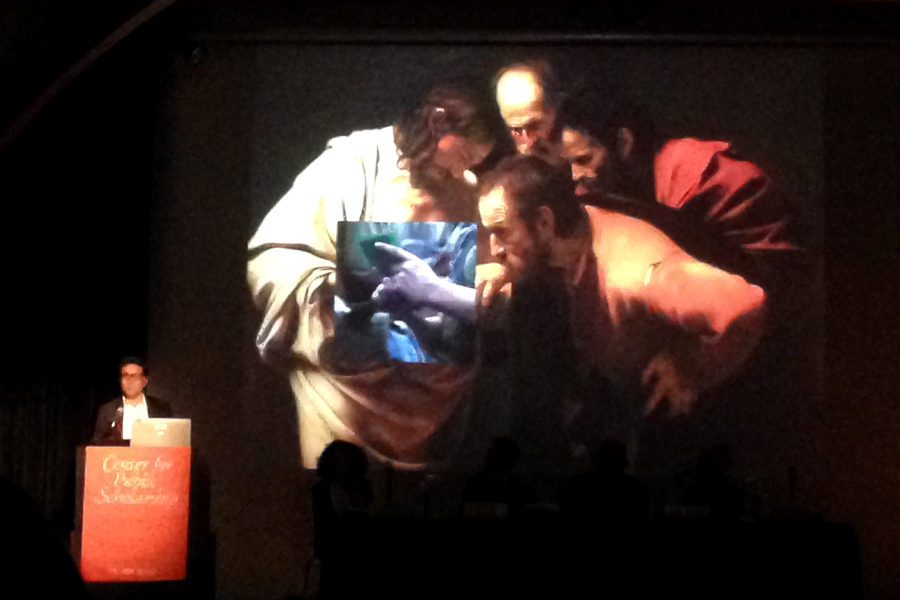
Jack Persekian – Caravaggio collaged with contemporary Palestinian reality.
Today, February 13th 2015, I attended the last two sessions of the New Schools “The Fear of Art” two-day conference. I have a few notes from the last panel.
Jeffrey Deitch: on mural of coffins with dollars by Blu… I’m sure that Jeffrey is familiar with the term “parachute artist”… why in this day and age would a museum and an artist create public work ignorant of the immediate community? It seems so unprofessional, disrespectful, naive, ignorant… inform oneself before creating a work, particularly a work destined for the public space. Some veterans protested against the white washing of the wall. They believed in what the mural portrayed – the union of money and war.
In the end a problematic image that created public outcry was short lived… It sounds like our mass media cycle – is this as art should function or the type of work and outcome that a museum desires? Deitch leaves it up to the artist, and that seems too easy. It is the makings for a lot of bad art getting a good run. What about the question of the maturity of the artist. By maturity, I mean an artist undertaking the responsibility to inform oneself, to talk with people, to do research and consider the nuances of a neat visual idea. If an artist informs herself and then proceeds with the work, great, but if an artist runs with a strong visual idea without carefully considering the meaning from various perspectives… then should this type of work be supported? Can research lead to self-sensorship?
Boris Groys: at museums pray to religious artifacts… always imagine what an ancient Egyptian or Greek or Aztec would feel or think if visiting a contemporary museum with these artifacts.
To offend people is a good thing to do because it provokes a reaction, it makes clear the attitude, it puts things on the table.
Lisa Phillips: the strongest art is disrespectful, problematic, because it’s a new way of seeing, a way of seeing that is disruptive and exists before entering the mainstream and being accepted.
Jack Persekian: Installation in preparation for the Pope’s visit to Palestine, images that merged Baroque art with current life of Palestinian’s… what we think of the Holy Land and what it means to live in the location… Carvaggio – Thomas asked to touch Jesus’s wounds – switched to identity card used to scan the finger print of Palestinian’s. The work turned out to be too confrontational to be presented to the pope.
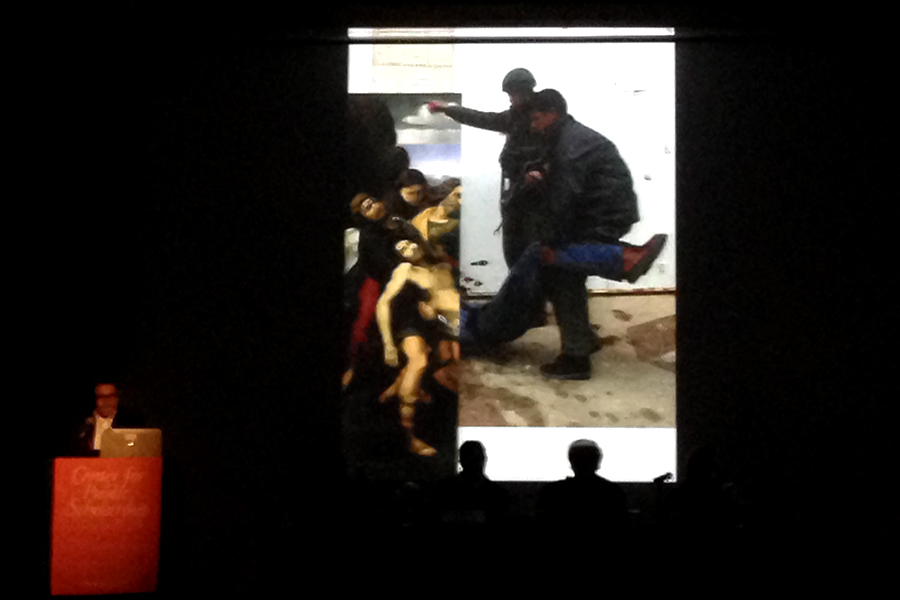
Jack Persekian – Baroque painting collaged with current Palestinian reality
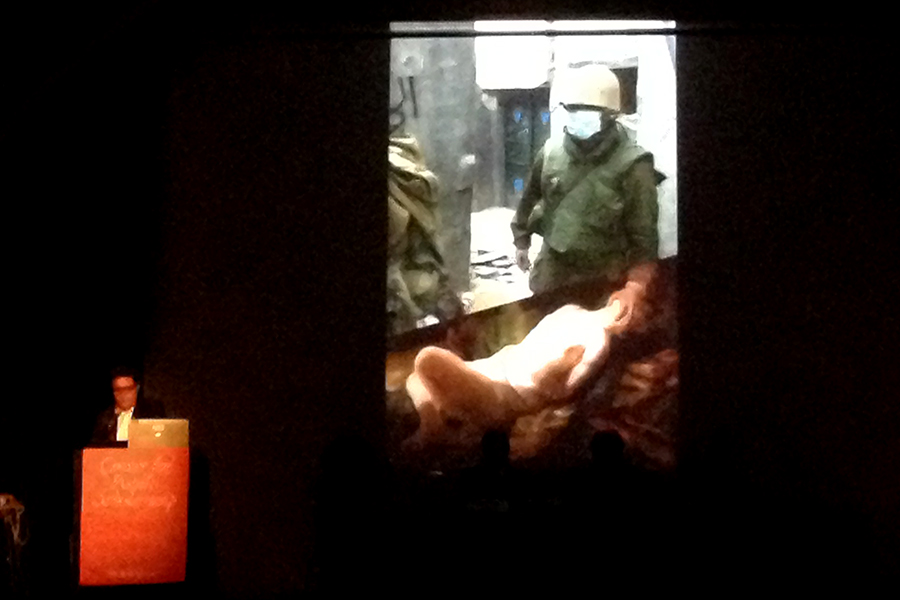
Jack Persekian – Baroque painting collaged with current Palestinian reality
Victoria Estok & Steve Lambert Show that Cops Believe in Climate Justice

Victoria Estok with NYPD for Climate Justice

Steve Lambert Posing with Police for Climate Justice
On Transmitting Ideology at El Museo del Barrio

On Transmitting Ideology
11 radio guns from “On Transmitting Ideology” will be on view as part of the exhibition “PLAYING WITH FIRE: Political Interventions, Dissident Acts, and Mischievous Actions” curated by Nicolás Dumit Estévez at El Museo del Barrio from September 6, 2014 – January 3, 2015.
The installation presents eleven wooden guns outfitted with radios broadcasting declarations on freedom and transformation in our society. The broadcast is an audio montage composed from snippets and portions of speeches by Calvin Coolidge, Reagan, Obama, MLK, Enoch Powell, Malcolm X, MacArthur, George Wallace (former governor of Alabama), Barry Goldwater, William F. Buckley and Noam Chomsky – speeches that have helped define contemporary conservative vs liberal ideology. The audio montage is available online: http://ambriente.com/ideology/
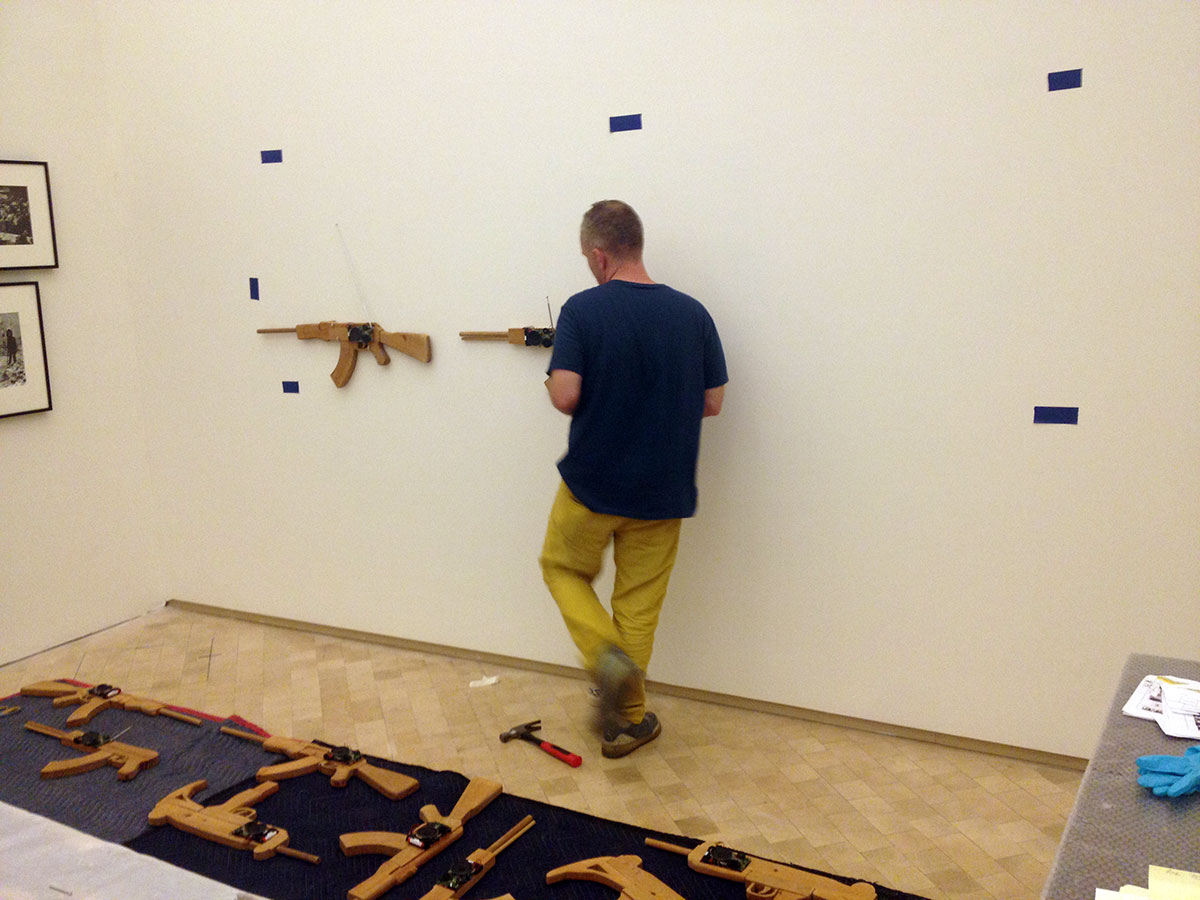
Installing “On Transmitting Ideology” at El Museo’s Carmen Ana Unanue gallery, September 3rd, 2014
“Vagaries of the Commons” at Artspace, New Haven, CT

EXCESS NYC at Artspace in New Haven, CT
“Vagaries of the Commons,” curated by Sarah Fritchey, will be on view July 25 through September 13. Brooke and I are participating in a group show revolving around the concept of the “commons” in today’s increasingly privatized public spaces. The curated artists are cultural producers that interact with the gray zones of private vs public to investigate various social issues.
Our food collection and compost bike for the ongoing project EXCESS NYC is on exhibit and on Saturday, September 13th, we will be collecting food and having a picnic as part of that day’s closing events.
Here’s the full description or go to the Artspace site that also includes links to the artists.
Artists and contributors include: Brad Armstrong, Ricardo Miranda and Brooke Singer; Lani Asuncion and Gary Aronsen; Mengyu Chen; The Elm City Dance Collective; Jason Friedes; Focus Lessness (Michael Romano and Milton Laüfer), Occupy New Haven; Phil Lique; Project Storefronts; Scott Shuldt; and Under 91 Project.
The concept of “the commons” predates the feudal era in early Germanic and Roman settlements, where communal land ownership prevailed. Originally, the concept referred to the public’s interest and right to access essential natural resources that are held in common and not owned privately, including land, water, animals and fish. Gradually, as royalty and then a central government gained power, the notion of communal land ownership disappeared and the concept of “the commons” evolved.
In 2014, this concept is increasingly complex. Legislation pertaining to the regulation and privatization of common space responds to changes in government, the economy, the sciences and our natural surroundings. Also, the concept of the commons extends far into the charted and uncharted vacuums of the digital realm.
This exhibition presents a group of artists, based in and around greater New Haven, who make works that operate within the penumbras and cracks of the legal systems that oversee its “commons”. These grey zones are the flexible and the often vague environments from which the show’s title takes its inspiration
The show identifies four specific sectors and human rights questions addressed by artists practicing in and around New Haven. These include: the material commons (who has the right to order the build and name structures, homes, cities, maps?), the knowledge commons (who has access higher education, public libraries, the internet?), the aesthetic commons (who has the right to define and control image production?) and the affective commons (how are emotions policed and kept public/private?). The essential question that each work asks is: who has the right to have a voice?
The exhibition is organized to mindfully accompany Laureline Kruse’s Mobile Museum Student Apprenticeship Program project, which will share an exhibition space with the show.
“Can City” by Studio Swine
Can City from Studio Swine on Vimeo.
This is a brilliant project by art/design collective Studio Swine (Azusa Murakami and Alexander Groves). With so much waste and stuff in the world, do we really need to keep producing more? This project recycles waste – used vegetable oil and aluminum cans to create new aluminum objects via a mobile foundry. It’s an inspiring project executed in Sao Paulo, Brazil.